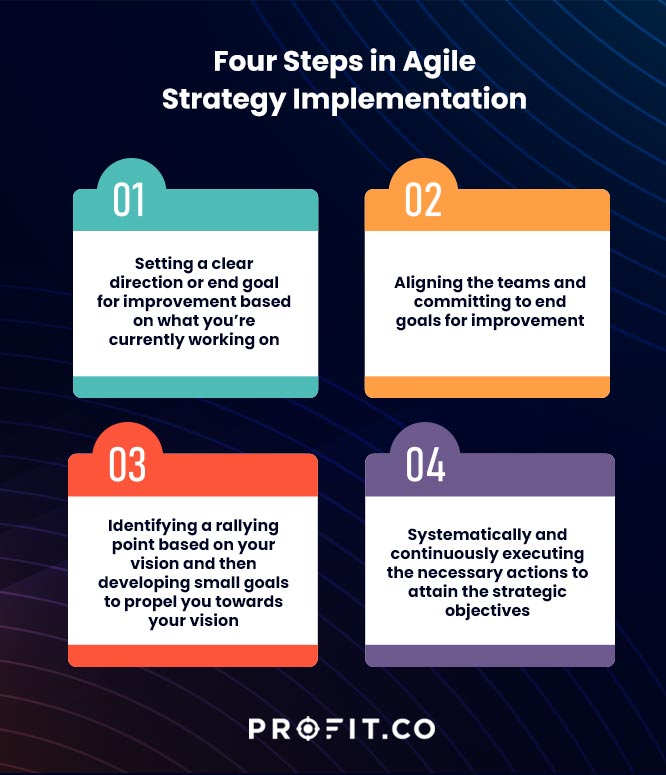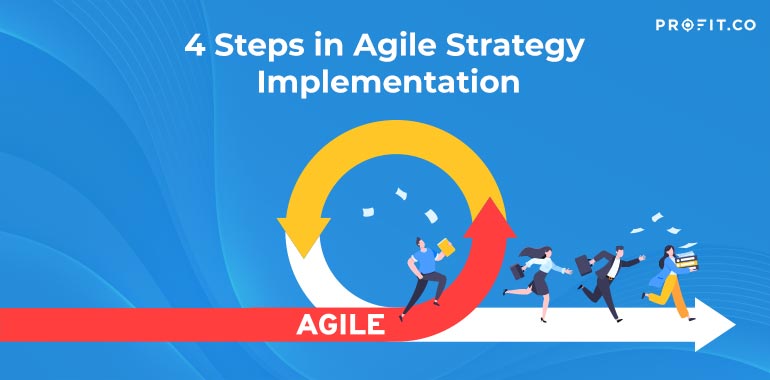An agile strategy enables an organization to swiftly and cost-efficiently respond to changes in the market or business environment.
Introduction
Agile strategies help corporations thrive and survive uncertain, volatile, and complex environments. Such strategies combine adaptability, preparedness, awareness, speed, and flexibility. Traditional strategies are more suitable for industries like manufacturing, where stable, long-term, and repetitive operations are necessary. Businesses and organizations face constant and consistent change in today’s world, so more than traditional strategies are needed.
It’s time to switch up the rigid cycles, tedious processes, and inflexible tools that hinder the decision-making process and extend the time to market. Agile strategies make it easier to achieve organizational goals. The ability to respond swiftly to constantly changing situations helps you recognize new, innovative opportunities. This allows you the opportunity and ability to exploit business opportunities and earn more profits. So, what exactly is an agile strategy, and how can you implement one? Let’s find out, shall we?
What is Agile Strategy?
Strategies enable businesses and organizations to create, define, adopt and execute plans to achieve ambitious objectives. Some strategies apply to particular departments, but others involve the entire corporation.
An agile strategy helps you create more elaborate plans to change in response to external events and issues in the business environment.
The flexibility involved in the planning ensures the strategy is always practical and relevant in complex, uncertain, and volatile environments.
The best way to ensure an agile strategy becomes successful is by
- Merging the phases of strategy development, adoption, and implementation into a continuous yet constantly evolving process
- Implementing the strategy in phases for regular, early testing to ensure effectiveness and identify areas of improvement
- Observing the external environment to determine if the strategy needs adjustments
- Ensuring everyone within the organization aligns with the strategy
Success today requires the agility and drive to constantly rethink, reinvigorate, react, and reinvent.
Shortfalls in Traditional Strategy Development and Implementation
Traditional strategies depend on meetings, documentation, and research to develop elaborate plans. Such strategies require careful deliberation with as much information as possible.
Traditional strategies are rigid and prevent agile methods from working. Implementing changes is challenging when working with a rigid annual plan with pre-determined steps. An Agile framework or agile project management requires agile strategies that function on a shared vision and purpose, working towards common goals.
Differences between Traditional and Agile Strategies
| Traditional Strategy | Agile Strategy |
| Depends on proper documentation to ensure the results are as per the description of the strategy. | Achieves results through mutual understanding of the vision without outlining the particular steps or process |
| The strategy is a hand-me-down from senior executives with minimal or no input from other team members. | Teams can leverage their expertise when deciding how to achieve common goals. |
| Set in stone and never change. | Updated and modified as necessary depending on the results of execution and teamwork. |
| Customer involvement is only in the early stages of a project rather than during execution. | Customer involvement starts from the beginning of the project and continues during the execution. |
| Any issues arising require escalation to higher-level managers. | The team collaborates to resolve any arising issues. |
| Traditional strategies work with anticipation. | Agile strategies thrive on adoption. |
| The focus is more on the processes, not the products. | There’s less focus on directive and formal processes. |
| Require rigorous approvals and reviews by management | Reviews occur after every iteration |
Book a free demo with our team to learn more about how OKR software can help implement your agile strategies to enhance your organization’s performance!
Core Principles of Agile Strategy
The agile strategy applies four core principles. Although they seem straightforward, it often takes hard work for teams to adopt the principles and abandon old ones.
- People First: Individuals and Interactions Over Processes and Tools
People respond to changing business needs, so they lead the development process. If the tools and processes lead the development, the team will respond poorly to the changes. Instead of prioritizing the latest technology, it’s best to focus on effective communication and collaboration to achieve results.
- Focus: Working Software over Comprehensive Documentation
Previously, most of the time went to documenting every aspect of a project. In most cases, ensuring proper documentation comes at the expense of the final product. The agile strategy not only does away with some documentation and streamlines documentation to prevent the paperwork from interfering with the final deliverables.
- Collaboration: Customer Collaboration over Contract Negotiation
An agile strategy requires customer involvement in all project phases. Instead of negotiating before or after the project, you need to collaborate with customers continuously. This ensures the customer gets what they want during the process to ensure the final product is satisfactory.
- Adaptability: Responding to Change Over Following a Plan
The agile strategy discourages developing detailed plans beforehand and abiding by them regardless of the situation. Circumstances change, so you must be able to respond swiftly to new demands and needs.

Four Steps in Agile Strategy Implementation
Agile Strategy execution is simple, yet it’s the most robust approach. It’s the most effective way to align to a unified direction and attain outstanding results for any business. Agile strategy execution will benefit from using a goal management tool like the OKR, which allows organizations to map their objectives to measurable key results, align the teams and execute goals seamlessly. OKR adoption can be ensured across the organization as it will improve the agility of all the stakeholders.
The Agile implementation includes these steps:
- Setting a clear direction or end goal for improvement based on what you’re currently working with
- Aligning the teams and committing to end goals for improvement
- Identifying a rallying point based on your vision and then developing small goals to propel you toward your vision
- Systematically and continuously executing the necessary actions to attain the strategic objectives
FAQs
- What are the Benefits of an Agile Strategy
- Enhances product quality
- Prioritizes flexibility
- Ensures more transparency
- Early and successful project delivery
- What is the Agile Manifesto?
The Agile Manifesto is a document co-authored by seventeen like-minded software practitioners in February 2001. The participants agreed on the four core principles of the agile strategy.
- What Are Some Challenges of Adopting an Agile Strategy?
The most common challenges organizations face with agile strategies include the following:
- Lack of support from management
- Inadequate experience with agile strategy execution methods
- Resistance from teams used to traditional methods
- Company philosophy failing to align with core agile values
- Inconsistent practices
Conclusion
Business environments will always be dynamic, complex, and unpredictable. Your strategies should focus on swift learning, testing, monitoring, and responding to changing circumstances. You need an agile strategy to ensure you can identify and leverage new innovative opportunities.
You can get started on Profit.co completely free today!

